Healthcare Report: Chronic Diseases, Management for Patient Jason
VerifiedAdded on 2021/04/21
|8
|2445
|51
Report
AI Summary
This report presents a comprehensive analysis of Jason's health condition, detailing his chronic diseases, including atrial fibrillation, chronic liver disease, and COPD, stemming from his lifestyle choices and medical history. The report discusses the potential complications associated with each condition and emphasizes the need for regular cardiac monitoring, liver function tests, and pulmonary assessments. Furthermore, it outlines a multi-faceted approach to improve Jason's health-related quality of life and adherence to treatment, including dietary modifications like the DASH diet, exercise, cognitive behavioral therapy, and regular follow-up sessions with healthcare professionals. A letter to the physiotherapist and dietician is included, requesting specific rehabilitation interventions to enhance Jason's physical function, medication adherence, and overall well-being, focusing on a holistic and person-centered approach. The report highlights the importance of interdisciplinary collaboration and patient self-management in improving outcomes and minimizing psychosocial complications. The report is a valuable resource, and Desklib provides additional study materials.
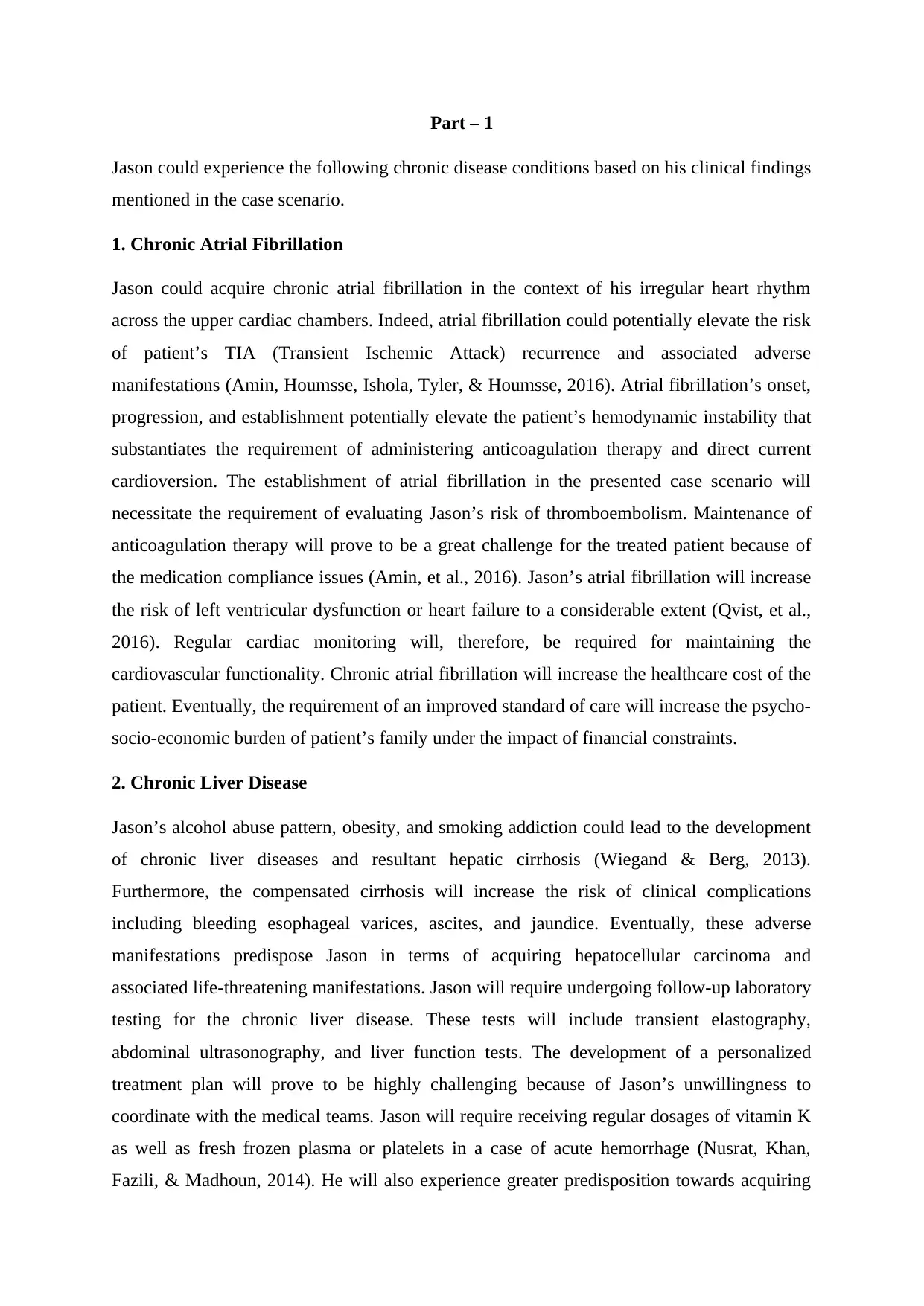
Part – 1
Jason could experience the following chronic disease conditions based on his clinical findings
mentioned in the case scenario.
1. Chronic Atrial Fibrillation
Jason could acquire chronic atrial fibrillation in the context of his irregular heart rhythm
across the upper cardiac chambers. Indeed, atrial fibrillation could potentially elevate the risk
of patient’s TIA (Transient Ischemic Attack) recurrence and associated adverse
manifestations (Amin, Houmsse, Ishola, Tyler, & Houmsse, 2016). Atrial fibrillation’s onset,
progression, and establishment potentially elevate the patient’s hemodynamic instability that
substantiates the requirement of administering anticoagulation therapy and direct current
cardioversion. The establishment of atrial fibrillation in the presented case scenario will
necessitate the requirement of evaluating Jason’s risk of thromboembolism. Maintenance of
anticoagulation therapy will prove to be a great challenge for the treated patient because of
the medication compliance issues (Amin, et al., 2016). Jason’s atrial fibrillation will increase
the risk of left ventricular dysfunction or heart failure to a considerable extent (Qvist, et al.,
2016). Regular cardiac monitoring will, therefore, be required for maintaining the
cardiovascular functionality. Chronic atrial fibrillation will increase the healthcare cost of the
patient. Eventually, the requirement of an improved standard of care will increase the psycho-
socio-economic burden of patient’s family under the impact of financial constraints.
2. Chronic Liver Disease
Jason’s alcohol abuse pattern, obesity, and smoking addiction could lead to the development
of chronic liver diseases and resultant hepatic cirrhosis (Wiegand & Berg, 2013).
Furthermore, the compensated cirrhosis will increase the risk of clinical complications
including bleeding esophageal varices, ascites, and jaundice. Eventually, these adverse
manifestations predispose Jason in terms of acquiring hepatocellular carcinoma and
associated life-threatening manifestations. Jason will require undergoing follow-up laboratory
testing for the chronic liver disease. These tests will include transient elastography,
abdominal ultrasonography, and liver function tests. The development of a personalized
treatment plan will prove to be highly challenging because of Jason’s unwillingness to
coordinate with the medical teams. Jason will require receiving regular dosages of vitamin K
as well as fresh frozen plasma or platelets in a case of acute hemorrhage (Nusrat, Khan,
Fazili, & Madhoun, 2014). He will also experience greater predisposition towards acquiring
Jason could experience the following chronic disease conditions based on his clinical findings
mentioned in the case scenario.
1. Chronic Atrial Fibrillation
Jason could acquire chronic atrial fibrillation in the context of his irregular heart rhythm
across the upper cardiac chambers. Indeed, atrial fibrillation could potentially elevate the risk
of patient’s TIA (Transient Ischemic Attack) recurrence and associated adverse
manifestations (Amin, Houmsse, Ishola, Tyler, & Houmsse, 2016). Atrial fibrillation’s onset,
progression, and establishment potentially elevate the patient’s hemodynamic instability that
substantiates the requirement of administering anticoagulation therapy and direct current
cardioversion. The establishment of atrial fibrillation in the presented case scenario will
necessitate the requirement of evaluating Jason’s risk of thromboembolism. Maintenance of
anticoagulation therapy will prove to be a great challenge for the treated patient because of
the medication compliance issues (Amin, et al., 2016). Jason’s atrial fibrillation will increase
the risk of left ventricular dysfunction or heart failure to a considerable extent (Qvist, et al.,
2016). Regular cardiac monitoring will, therefore, be required for maintaining the
cardiovascular functionality. Chronic atrial fibrillation will increase the healthcare cost of the
patient. Eventually, the requirement of an improved standard of care will increase the psycho-
socio-economic burden of patient’s family under the impact of financial constraints.
2. Chronic Liver Disease
Jason’s alcohol abuse pattern, obesity, and smoking addiction could lead to the development
of chronic liver diseases and resultant hepatic cirrhosis (Wiegand & Berg, 2013).
Furthermore, the compensated cirrhosis will increase the risk of clinical complications
including bleeding esophageal varices, ascites, and jaundice. Eventually, these adverse
manifestations predispose Jason in terms of acquiring hepatocellular carcinoma and
associated life-threatening manifestations. Jason will require undergoing follow-up laboratory
testing for the chronic liver disease. These tests will include transient elastography,
abdominal ultrasonography, and liver function tests. The development of a personalized
treatment plan will prove to be highly challenging because of Jason’s unwillingness to
coordinate with the medical teams. Jason will require receiving regular dosages of vitamin K
as well as fresh frozen plasma or platelets in a case of acute hemorrhage (Nusrat, Khan,
Fazili, & Madhoun, 2014). He will also experience greater predisposition towards acquiring
Paraphrase This Document
Need a fresh take? Get an instant paraphrase of this document with our AI Paraphraser
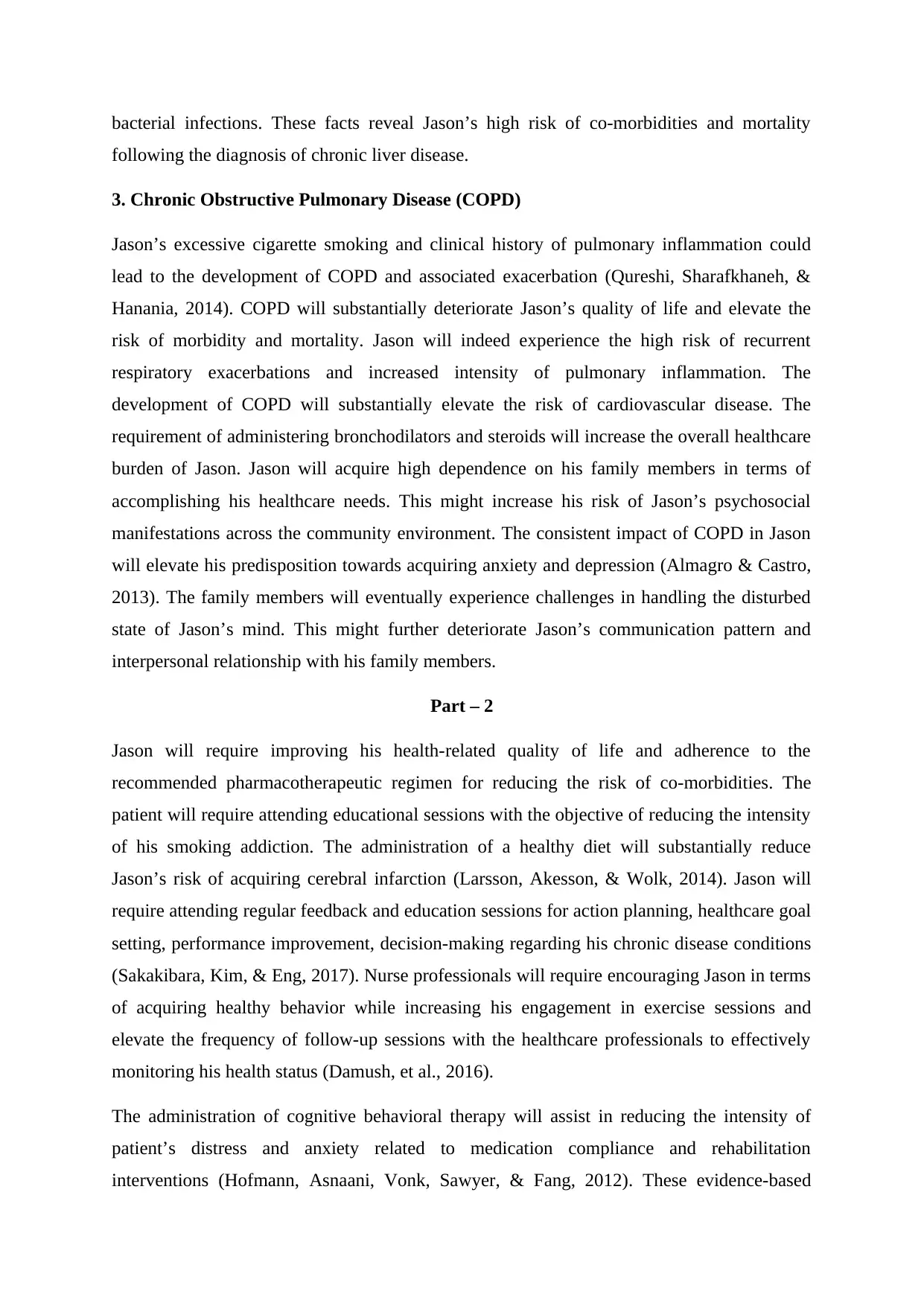
bacterial infections. These facts reveal Jason’s high risk of co-morbidities and mortality
following the diagnosis of chronic liver disease.
3. Chronic Obstructive Pulmonary Disease (COPD)
Jason’s excessive cigarette smoking and clinical history of pulmonary inflammation could
lead to the development of COPD and associated exacerbation (Qureshi, Sharafkhaneh, &
Hanania, 2014). COPD will substantially deteriorate Jason’s quality of life and elevate the
risk of morbidity and mortality. Jason will indeed experience the high risk of recurrent
respiratory exacerbations and increased intensity of pulmonary inflammation. The
development of COPD will substantially elevate the risk of cardiovascular disease. The
requirement of administering bronchodilators and steroids will increase the overall healthcare
burden of Jason. Jason will acquire high dependence on his family members in terms of
accomplishing his healthcare needs. This might increase his risk of Jason’s psychosocial
manifestations across the community environment. The consistent impact of COPD in Jason
will elevate his predisposition towards acquiring anxiety and depression (Almagro & Castro,
2013). The family members will eventually experience challenges in handling the disturbed
state of Jason’s mind. This might further deteriorate Jason’s communication pattern and
interpersonal relationship with his family members.
Part – 2
Jason will require improving his health-related quality of life and adherence to the
recommended pharmacotherapeutic regimen for reducing the risk of co-morbidities. The
patient will require attending educational sessions with the objective of reducing the intensity
of his smoking addiction. The administration of a healthy diet will substantially reduce
Jason’s risk of acquiring cerebral infarction (Larsson, Akesson, & Wolk, 2014). Jason will
require attending regular feedback and education sessions for action planning, healthcare goal
setting, performance improvement, decision-making regarding his chronic disease conditions
(Sakakibara, Kim, & Eng, 2017). Nurse professionals will require encouraging Jason in terms
of acquiring healthy behavior while increasing his engagement in exercise sessions and
elevate the frequency of follow-up sessions with the healthcare professionals to effectively
monitoring his health status (Damush, et al., 2016).
The administration of cognitive behavioral therapy will assist in reducing the intensity of
patient’s distress and anxiety related to medication compliance and rehabilitation
interventions (Hofmann, Asnaani, Vonk, Sawyer, & Fang, 2012). These evidence-based
following the diagnosis of chronic liver disease.
3. Chronic Obstructive Pulmonary Disease (COPD)
Jason’s excessive cigarette smoking and clinical history of pulmonary inflammation could
lead to the development of COPD and associated exacerbation (Qureshi, Sharafkhaneh, &
Hanania, 2014). COPD will substantially deteriorate Jason’s quality of life and elevate the
risk of morbidity and mortality. Jason will indeed experience the high risk of recurrent
respiratory exacerbations and increased intensity of pulmonary inflammation. The
development of COPD will substantially elevate the risk of cardiovascular disease. The
requirement of administering bronchodilators and steroids will increase the overall healthcare
burden of Jason. Jason will acquire high dependence on his family members in terms of
accomplishing his healthcare needs. This might increase his risk of Jason’s psychosocial
manifestations across the community environment. The consistent impact of COPD in Jason
will elevate his predisposition towards acquiring anxiety and depression (Almagro & Castro,
2013). The family members will eventually experience challenges in handling the disturbed
state of Jason’s mind. This might further deteriorate Jason’s communication pattern and
interpersonal relationship with his family members.
Part – 2
Jason will require improving his health-related quality of life and adherence to the
recommended pharmacotherapeutic regimen for reducing the risk of co-morbidities. The
patient will require attending educational sessions with the objective of reducing the intensity
of his smoking addiction. The administration of a healthy diet will substantially reduce
Jason’s risk of acquiring cerebral infarction (Larsson, Akesson, & Wolk, 2014). Jason will
require attending regular feedback and education sessions for action planning, healthcare goal
setting, performance improvement, decision-making regarding his chronic disease conditions
(Sakakibara, Kim, & Eng, 2017). Nurse professionals will require encouraging Jason in terms
of acquiring healthy behavior while increasing his engagement in exercise sessions and
elevate the frequency of follow-up sessions with the healthcare professionals to effectively
monitoring his health status (Damush, et al., 2016).
The administration of cognitive behavioral therapy will assist in reducing the intensity of
patient’s distress and anxiety related to medication compliance and rehabilitation
interventions (Hofmann, Asnaani, Vonk, Sawyer, & Fang, 2012). These evidence-based
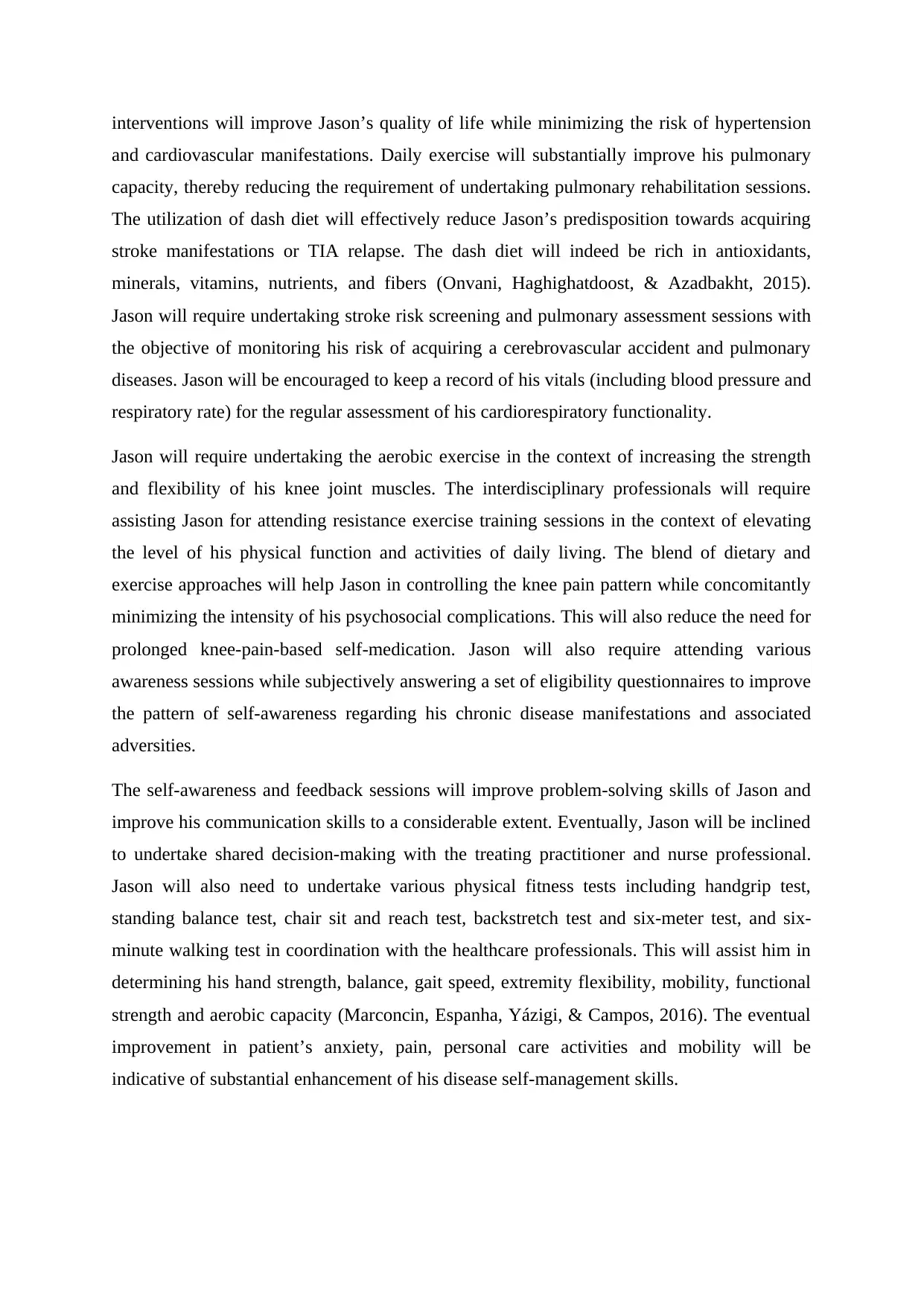
interventions will improve Jason’s quality of life while minimizing the risk of hypertension
and cardiovascular manifestations. Daily exercise will substantially improve his pulmonary
capacity, thereby reducing the requirement of undertaking pulmonary rehabilitation sessions.
The utilization of dash diet will effectively reduce Jason’s predisposition towards acquiring
stroke manifestations or TIA relapse. The dash diet will indeed be rich in antioxidants,
minerals, vitamins, nutrients, and fibers (Onvani, Haghighatdoost, & Azadbakht, 2015).
Jason will require undertaking stroke risk screening and pulmonary assessment sessions with
the objective of monitoring his risk of acquiring a cerebrovascular accident and pulmonary
diseases. Jason will be encouraged to keep a record of his vitals (including blood pressure and
respiratory rate) for the regular assessment of his cardiorespiratory functionality.
Jason will require undertaking the aerobic exercise in the context of increasing the strength
and flexibility of his knee joint muscles. The interdisciplinary professionals will require
assisting Jason for attending resistance exercise training sessions in the context of elevating
the level of his physical function and activities of daily living. The blend of dietary and
exercise approaches will help Jason in controlling the knee pain pattern while concomitantly
minimizing the intensity of his psychosocial complications. This will also reduce the need for
prolonged knee-pain-based self-medication. Jason will also require attending various
awareness sessions while subjectively answering a set of eligibility questionnaires to improve
the pattern of self-awareness regarding his chronic disease manifestations and associated
adversities.
The self-awareness and feedback sessions will improve problem-solving skills of Jason and
improve his communication skills to a considerable extent. Eventually, Jason will be inclined
to undertake shared decision-making with the treating practitioner and nurse professional.
Jason will also need to undertake various physical fitness tests including handgrip test,
standing balance test, chair sit and reach test, backstretch test and six-meter test, and six-
minute walking test in coordination with the healthcare professionals. This will assist him in
determining his hand strength, balance, gait speed, extremity flexibility, mobility, functional
strength and aerobic capacity (Marconcin, Espanha, Yázigi, & Campos, 2016). The eventual
improvement in patient’s anxiety, pain, personal care activities and mobility will be
indicative of substantial enhancement of his disease self-management skills.
and cardiovascular manifestations. Daily exercise will substantially improve his pulmonary
capacity, thereby reducing the requirement of undertaking pulmonary rehabilitation sessions.
The utilization of dash diet will effectively reduce Jason’s predisposition towards acquiring
stroke manifestations or TIA relapse. The dash diet will indeed be rich in antioxidants,
minerals, vitamins, nutrients, and fibers (Onvani, Haghighatdoost, & Azadbakht, 2015).
Jason will require undertaking stroke risk screening and pulmonary assessment sessions with
the objective of monitoring his risk of acquiring a cerebrovascular accident and pulmonary
diseases. Jason will be encouraged to keep a record of his vitals (including blood pressure and
respiratory rate) for the regular assessment of his cardiorespiratory functionality.
Jason will require undertaking the aerobic exercise in the context of increasing the strength
and flexibility of his knee joint muscles. The interdisciplinary professionals will require
assisting Jason for attending resistance exercise training sessions in the context of elevating
the level of his physical function and activities of daily living. The blend of dietary and
exercise approaches will help Jason in controlling the knee pain pattern while concomitantly
minimizing the intensity of his psychosocial complications. This will also reduce the need for
prolonged knee-pain-based self-medication. Jason will also require attending various
awareness sessions while subjectively answering a set of eligibility questionnaires to improve
the pattern of self-awareness regarding his chronic disease manifestations and associated
adversities.
The self-awareness and feedback sessions will improve problem-solving skills of Jason and
improve his communication skills to a considerable extent. Eventually, Jason will be inclined
to undertake shared decision-making with the treating practitioner and nurse professional.
Jason will also need to undertake various physical fitness tests including handgrip test,
standing balance test, chair sit and reach test, backstretch test and six-meter test, and six-
minute walking test in coordination with the healthcare professionals. This will assist him in
determining his hand strength, balance, gait speed, extremity flexibility, mobility, functional
strength and aerobic capacity (Marconcin, Espanha, Yázigi, & Campos, 2016). The eventual
improvement in patient’s anxiety, pain, personal care activities and mobility will be
indicative of substantial enhancement of his disease self-management skills.
⊘ This is a preview!⊘
Do you want full access?
Subscribe today to unlock all pages.

Trusted by 1+ million students worldwide
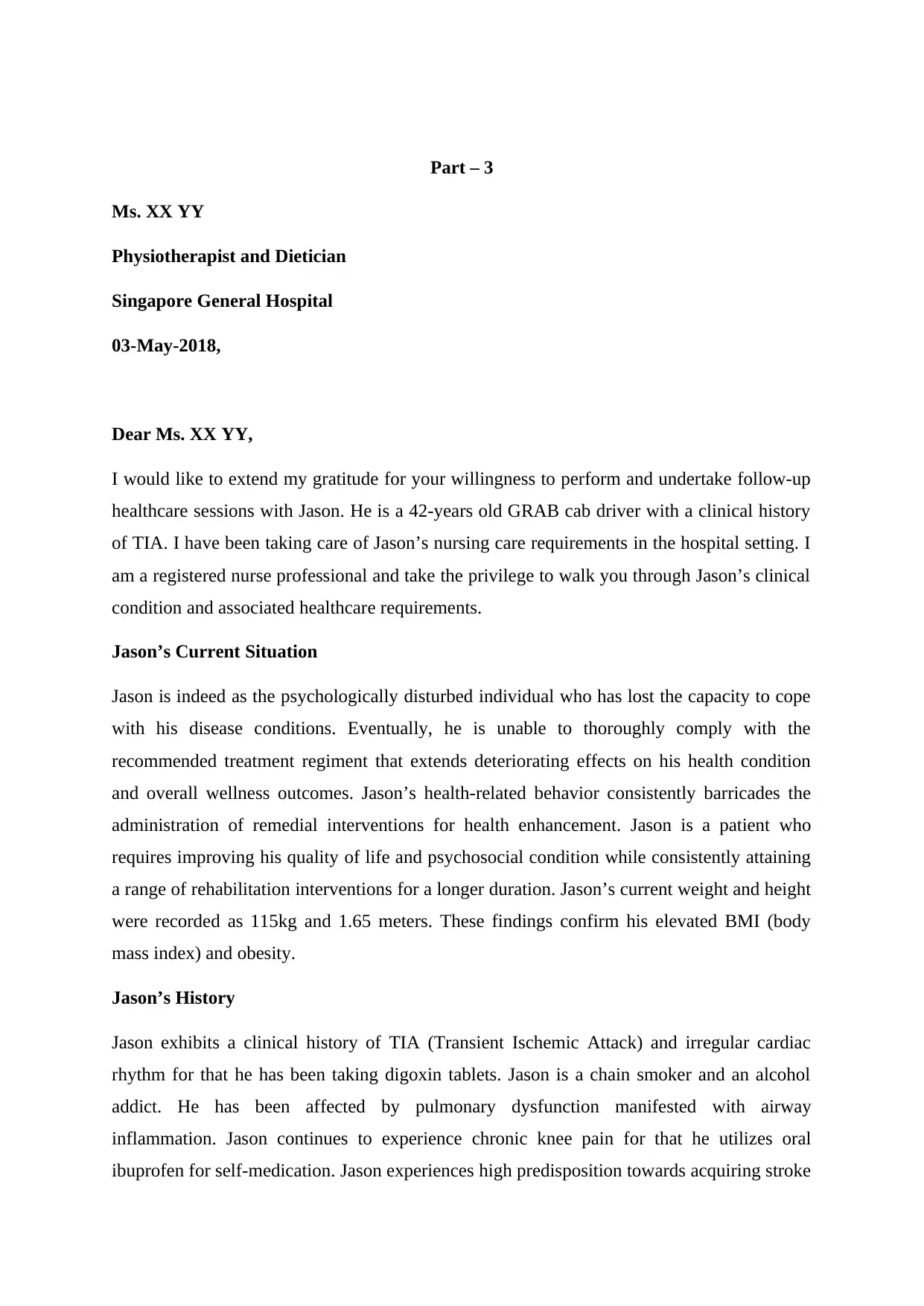
Part – 3
Ms. XX YY
Physiotherapist and Dietician
Singapore General Hospital
03-May-2018,
Dear Ms. XX YY,
I would like to extend my gratitude for your willingness to perform and undertake follow-up
healthcare sessions with Jason. He is a 42-years old GRAB cab driver with a clinical history
of TIA. I have been taking care of Jason’s nursing care requirements in the hospital setting. I
am a registered nurse professional and take the privilege to walk you through Jason’s clinical
condition and associated healthcare requirements.
Jason’s Current Situation
Jason is indeed as the psychologically disturbed individual who has lost the capacity to cope
with his disease conditions. Eventually, he is unable to thoroughly comply with the
recommended treatment regiment that extends deteriorating effects on his health condition
and overall wellness outcomes. Jason’s health-related behavior consistently barricades the
administration of remedial interventions for health enhancement. Jason is a patient who
requires improving his quality of life and psychosocial condition while consistently attaining
a range of rehabilitation interventions for a longer duration. Jason’s current weight and height
were recorded as 115kg and 1.65 meters. These findings confirm his elevated BMI (body
mass index) and obesity.
Jason’s History
Jason exhibits a clinical history of TIA (Transient Ischemic Attack) and irregular cardiac
rhythm for that he has been taking digoxin tablets. Jason is a chain smoker and an alcohol
addict. He has been affected by pulmonary dysfunction manifested with airway
inflammation. Jason continues to experience chronic knee pain for that he utilizes oral
ibuprofen for self-medication. Jason experiences high predisposition towards acquiring stroke
Ms. XX YY
Physiotherapist and Dietician
Singapore General Hospital
03-May-2018,
Dear Ms. XX YY,
I would like to extend my gratitude for your willingness to perform and undertake follow-up
healthcare sessions with Jason. He is a 42-years old GRAB cab driver with a clinical history
of TIA. I have been taking care of Jason’s nursing care requirements in the hospital setting. I
am a registered nurse professional and take the privilege to walk you through Jason’s clinical
condition and associated healthcare requirements.
Jason’s Current Situation
Jason is indeed as the psychologically disturbed individual who has lost the capacity to cope
with his disease conditions. Eventually, he is unable to thoroughly comply with the
recommended treatment regiment that extends deteriorating effects on his health condition
and overall wellness outcomes. Jason’s health-related behavior consistently barricades the
administration of remedial interventions for health enhancement. Jason is a patient who
requires improving his quality of life and psychosocial condition while consistently attaining
a range of rehabilitation interventions for a longer duration. Jason’s current weight and height
were recorded as 115kg and 1.65 meters. These findings confirm his elevated BMI (body
mass index) and obesity.
Jason’s History
Jason exhibits a clinical history of TIA (Transient Ischemic Attack) and irregular cardiac
rhythm for that he has been taking digoxin tablets. Jason is a chain smoker and an alcohol
addict. He has been affected by pulmonary dysfunction manifested with airway
inflammation. Jason continues to experience chronic knee pain for that he utilizes oral
ibuprofen for self-medication. Jason experiences high predisposition towards acquiring stroke
Paraphrase This Document
Need a fresh take? Get an instant paraphrase of this document with our AI Paraphraser
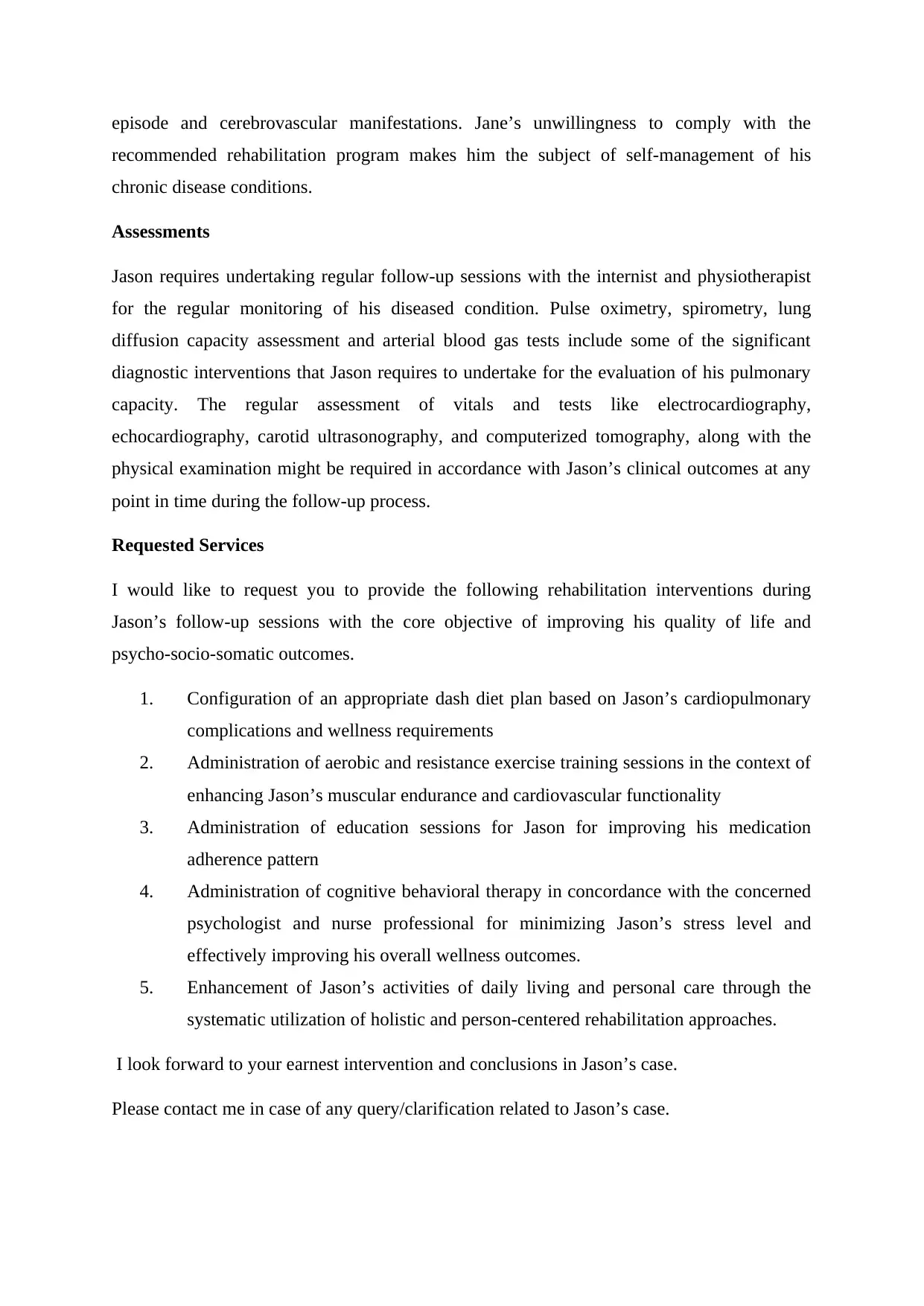
episode and cerebrovascular manifestations. Jane’s unwillingness to comply with the
recommended rehabilitation program makes him the subject of self-management of his
chronic disease conditions.
Assessments
Jason requires undertaking regular follow-up sessions with the internist and physiotherapist
for the regular monitoring of his diseased condition. Pulse oximetry, spirometry, lung
diffusion capacity assessment and arterial blood gas tests include some of the significant
diagnostic interventions that Jason requires to undertake for the evaluation of his pulmonary
capacity. The regular assessment of vitals and tests like electrocardiography,
echocardiography, carotid ultrasonography, and computerized tomography, along with the
physical examination might be required in accordance with Jason’s clinical outcomes at any
point in time during the follow-up process.
Requested Services
I would like to request you to provide the following rehabilitation interventions during
Jason’s follow-up sessions with the core objective of improving his quality of life and
psycho-socio-somatic outcomes.
1. Configuration of an appropriate dash diet plan based on Jason’s cardiopulmonary
complications and wellness requirements
2. Administration of aerobic and resistance exercise training sessions in the context of
enhancing Jason’s muscular endurance and cardiovascular functionality
3. Administration of education sessions for Jason for improving his medication
adherence pattern
4. Administration of cognitive behavioral therapy in concordance with the concerned
psychologist and nurse professional for minimizing Jason’s stress level and
effectively improving his overall wellness outcomes.
5. Enhancement of Jason’s activities of daily living and personal care through the
systematic utilization of holistic and person-centered rehabilitation approaches.
I look forward to your earnest intervention and conclusions in Jason’s case.
Please contact me in case of any query/clarification related to Jason’s case.
recommended rehabilitation program makes him the subject of self-management of his
chronic disease conditions.
Assessments
Jason requires undertaking regular follow-up sessions with the internist and physiotherapist
for the regular monitoring of his diseased condition. Pulse oximetry, spirometry, lung
diffusion capacity assessment and arterial blood gas tests include some of the significant
diagnostic interventions that Jason requires to undertake for the evaluation of his pulmonary
capacity. The regular assessment of vitals and tests like electrocardiography,
echocardiography, carotid ultrasonography, and computerized tomography, along with the
physical examination might be required in accordance with Jason’s clinical outcomes at any
point in time during the follow-up process.
Requested Services
I would like to request you to provide the following rehabilitation interventions during
Jason’s follow-up sessions with the core objective of improving his quality of life and
psycho-socio-somatic outcomes.
1. Configuration of an appropriate dash diet plan based on Jason’s cardiopulmonary
complications and wellness requirements
2. Administration of aerobic and resistance exercise training sessions in the context of
enhancing Jason’s muscular endurance and cardiovascular functionality
3. Administration of education sessions for Jason for improving his medication
adherence pattern
4. Administration of cognitive behavioral therapy in concordance with the concerned
psychologist and nurse professional for minimizing Jason’s stress level and
effectively improving his overall wellness outcomes.
5. Enhancement of Jason’s activities of daily living and personal care through the
systematic utilization of holistic and person-centered rehabilitation approaches.
I look forward to your earnest intervention and conclusions in Jason’s case.
Please contact me in case of any query/clarification related to Jason’s case.

Yours’ Sincerely,
Registered Nurse Professional
Contact Details: #_________
_______________________
Registered Nurse Professional
Contact Details: #_________
_______________________
⊘ This is a preview!⊘
Do you want full access?
Subscribe today to unlock all pages.

Trusted by 1+ million students worldwide
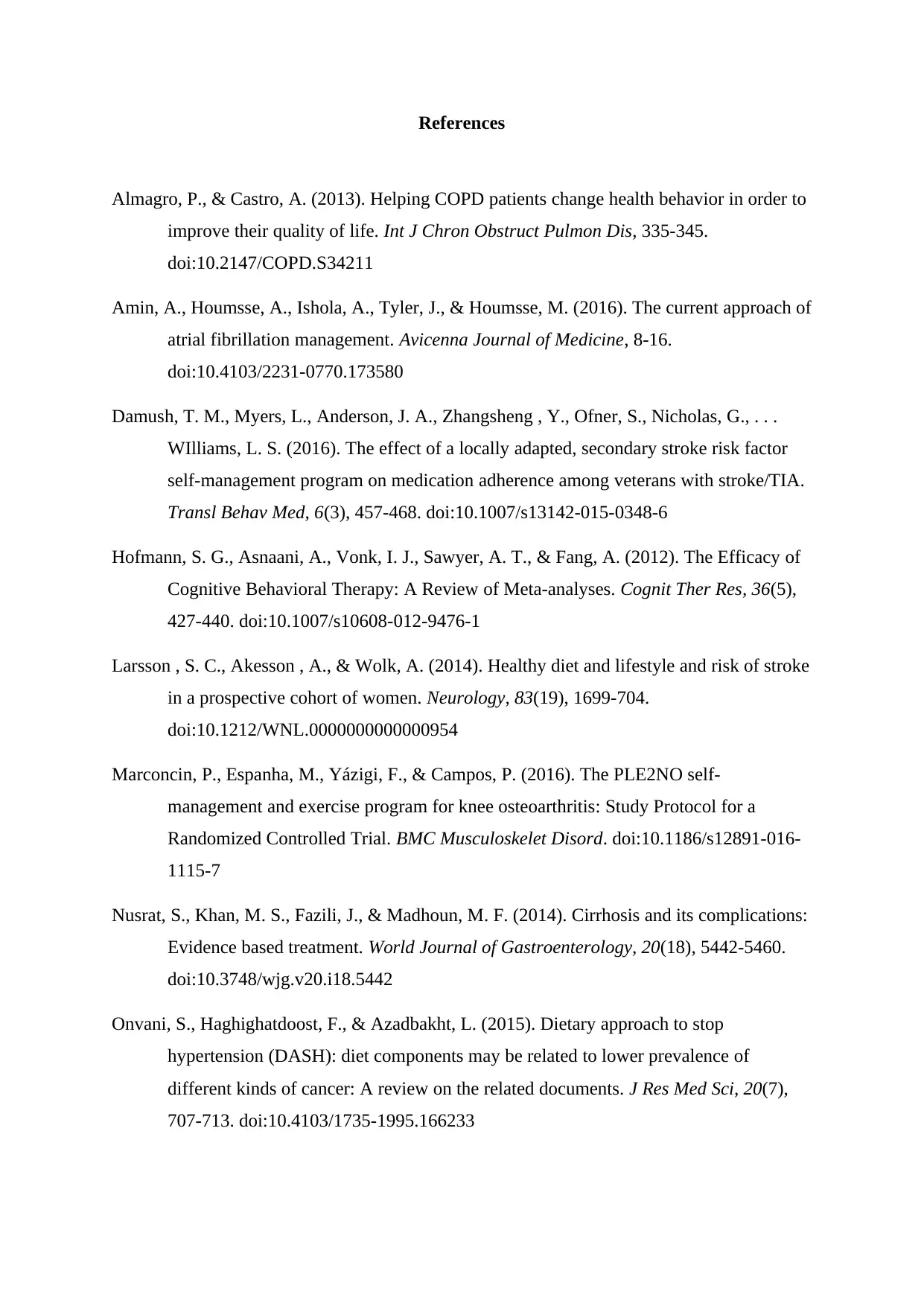
References
Almagro, P., & Castro, A. (2013). Helping COPD patients change health behavior in order to
improve their quality of life. Int J Chron Obstruct Pulmon Dis, 335-345.
doi:10.2147/COPD.S34211
Amin, A., Houmsse, A., Ishola, A., Tyler, J., & Houmsse, M. (2016). The current approach of
atrial fibrillation management. Avicenna Journal of Medicine, 8-16.
doi:10.4103/2231-0770.173580
Damush, T. M., Myers, L., Anderson, J. A., Zhangsheng , Y., Ofner, S., Nicholas, G., . . .
WIlliams, L. S. (2016). The effect of a locally adapted, secondary stroke risk factor
self-management program on medication adherence among veterans with stroke/TIA.
Transl Behav Med, 6(3), 457-468. doi:10.1007/s13142-015-0348-6
Hofmann, S. G., Asnaani, A., Vonk, I. J., Sawyer, A. T., & Fang, A. (2012). The Efficacy of
Cognitive Behavioral Therapy: A Review of Meta-analyses. Cognit Ther Res, 36(5),
427-440. doi:10.1007/s10608-012-9476-1
Larsson , S. C., Akesson , A., & Wolk, A. (2014). Healthy diet and lifestyle and risk of stroke
in a prospective cohort of women. Neurology, 83(19), 1699-704.
doi:10.1212/WNL.0000000000000954
Marconcin, P., Espanha, M., Yázigi, F., & Campos, P. (2016). The PLE2NO self-
management and exercise program for knee osteoarthritis: Study Protocol for a
Randomized Controlled Trial. BMC Musculoskelet Disord. doi:10.1186/s12891-016-
1115-7
Nusrat, S., Khan, M. S., Fazili, J., & Madhoun, M. F. (2014). Cirrhosis and its complications:
Evidence based treatment. World Journal of Gastroenterology, 20(18), 5442-5460.
doi:10.3748/wjg.v20.i18.5442
Onvani, S., Haghighatdoost, F., & Azadbakht, L. (2015). Dietary approach to stop
hypertension (DASH): diet components may be related to lower prevalence of
different kinds of cancer: A review on the related documents. J Res Med Sci, 20(7),
707-713. doi:10.4103/1735-1995.166233
Almagro, P., & Castro, A. (2013). Helping COPD patients change health behavior in order to
improve their quality of life. Int J Chron Obstruct Pulmon Dis, 335-345.
doi:10.2147/COPD.S34211
Amin, A., Houmsse, A., Ishola, A., Tyler, J., & Houmsse, M. (2016). The current approach of
atrial fibrillation management. Avicenna Journal of Medicine, 8-16.
doi:10.4103/2231-0770.173580
Damush, T. M., Myers, L., Anderson, J. A., Zhangsheng , Y., Ofner, S., Nicholas, G., . . .
WIlliams, L. S. (2016). The effect of a locally adapted, secondary stroke risk factor
self-management program on medication adherence among veterans with stroke/TIA.
Transl Behav Med, 6(3), 457-468. doi:10.1007/s13142-015-0348-6
Hofmann, S. G., Asnaani, A., Vonk, I. J., Sawyer, A. T., & Fang, A. (2012). The Efficacy of
Cognitive Behavioral Therapy: A Review of Meta-analyses. Cognit Ther Res, 36(5),
427-440. doi:10.1007/s10608-012-9476-1
Larsson , S. C., Akesson , A., & Wolk, A. (2014). Healthy diet and lifestyle and risk of stroke
in a prospective cohort of women. Neurology, 83(19), 1699-704.
doi:10.1212/WNL.0000000000000954
Marconcin, P., Espanha, M., Yázigi, F., & Campos, P. (2016). The PLE2NO self-
management and exercise program for knee osteoarthritis: Study Protocol for a
Randomized Controlled Trial. BMC Musculoskelet Disord. doi:10.1186/s12891-016-
1115-7
Nusrat, S., Khan, M. S., Fazili, J., & Madhoun, M. F. (2014). Cirrhosis and its complications:
Evidence based treatment. World Journal of Gastroenterology, 20(18), 5442-5460.
doi:10.3748/wjg.v20.i18.5442
Onvani, S., Haghighatdoost, F., & Azadbakht, L. (2015). Dietary approach to stop
hypertension (DASH): diet components may be related to lower prevalence of
different kinds of cancer: A review on the related documents. J Res Med Sci, 20(7),
707-713. doi:10.4103/1735-1995.166233
Paraphrase This Document
Need a fresh take? Get an instant paraphrase of this document with our AI Paraphraser
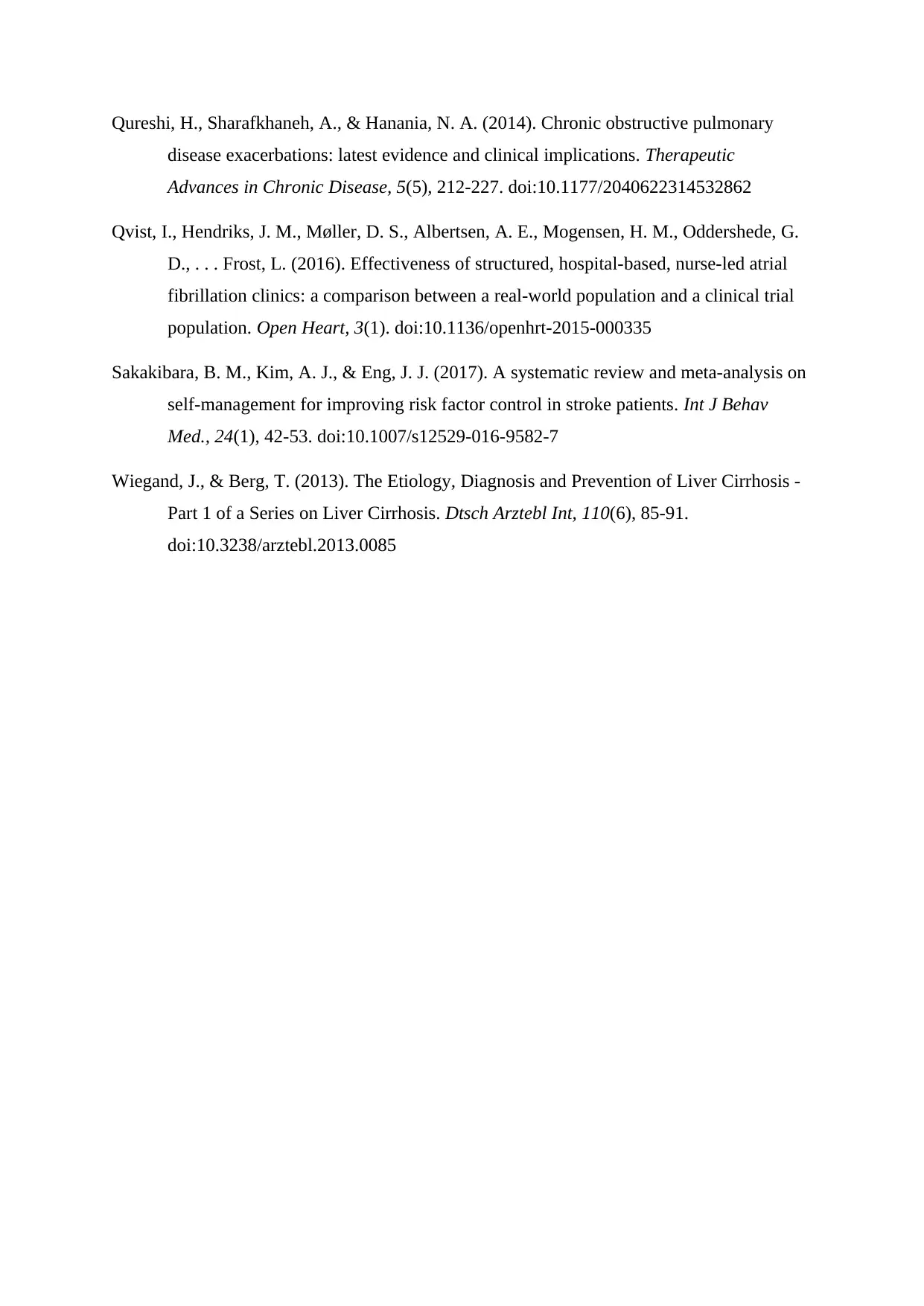
Qureshi, H., Sharafkhaneh, A., & Hanania, N. A. (2014). Chronic obstructive pulmonary
disease exacerbations: latest evidence and clinical implications. Therapeutic
Advances in Chronic Disease, 5(5), 212-227. doi:10.1177/2040622314532862
Qvist, I., Hendriks, J. M., Møller, D. S., Albertsen, A. E., Mogensen, H. M., Oddershede, G.
D., . . . Frost, L. (2016). Effectiveness of structured, hospital-based, nurse-led atrial
fibrillation clinics: a comparison between a real-world population and a clinical trial
population. Open Heart, 3(1). doi:10.1136/openhrt-2015-000335
Sakakibara, B. M., Kim, A. J., & Eng, J. J. (2017). A systematic review and meta-analysis on
self-management for improving risk factor control in stroke patients. Int J Behav
Med., 24(1), 42-53. doi:10.1007/s12529-016-9582-7
Wiegand, J., & Berg, T. (2013). The Etiology, Diagnosis and Prevention of Liver Cirrhosis -
Part 1 of a Series on Liver Cirrhosis. Dtsch Arztebl Int, 110(6), 85-91.
doi:10.3238/arztebl.2013.0085
disease exacerbations: latest evidence and clinical implications. Therapeutic
Advances in Chronic Disease, 5(5), 212-227. doi:10.1177/2040622314532862
Qvist, I., Hendriks, J. M., Møller, D. S., Albertsen, A. E., Mogensen, H. M., Oddershede, G.
D., . . . Frost, L. (2016). Effectiveness of structured, hospital-based, nurse-led atrial
fibrillation clinics: a comparison between a real-world population and a clinical trial
population. Open Heart, 3(1). doi:10.1136/openhrt-2015-000335
Sakakibara, B. M., Kim, A. J., & Eng, J. J. (2017). A systematic review and meta-analysis on
self-management for improving risk factor control in stroke patients. Int J Behav
Med., 24(1), 42-53. doi:10.1007/s12529-016-9582-7
Wiegand, J., & Berg, T. (2013). The Etiology, Diagnosis and Prevention of Liver Cirrhosis -
Part 1 of a Series on Liver Cirrhosis. Dtsch Arztebl Int, 110(6), 85-91.
doi:10.3238/arztebl.2013.0085
1 out of 8
Your All-in-One AI-Powered Toolkit for Academic Success.
+13062052269
info@desklib.com
Available 24*7 on WhatsApp / Email
![[object Object]](/_next/static/media/star-bottom.7253800d.svg)
Unlock your academic potential
Copyright © 2020–2025 A2Z Services. All Rights Reserved. Developed and managed by ZUCOL.

